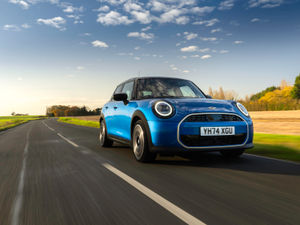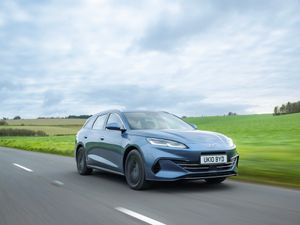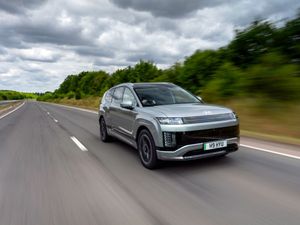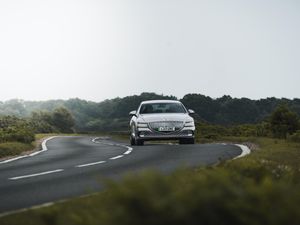Evolution, not revolution, is key to new Mazda CX-5
Mazda’s Qashqai-rivalling SUV has been subjected to a heavy facelift, and as James Fossdyke discovered, it’s simply a case of evolving the breed.
What’s new?
Mazda will tell you that its new CX-5 really is all new, but don’t be fooled. Yes, every body panel is new, but the Japanese brand freely admits that the design is more about progressing the look that went before, rather than a total reinvention.
The interior has been updated, too, with an almost totally revamped dashboard. The switchgear is the same as before though, and although the infotainment system lives in a different housing, it’s still the same system.
Under the skin, the new CX-5 uses the same platform and powertrains as its predecessor, although the G-Vectoring Control torque-vectoring system from the Mazda6 has been fitted to improve handling.

Looks and image
The new CX-5 may not feature the wholesale changes we were expecting, but it has been thoroughly modernised. The designers have done away with the old car’s rounded edges, replacing them with sharper lines and a very lightly modified stance.
Although they couldn’t change the car’s dimensions, they have lengthened the bonnet by bringing the leading edge forward and moving the A-pillars back by a few millimetres, giving the car an altogether sportier look.
Further back, the two styling lines on the sides have been modified to make better use of reflections, which give the car a much more active look without making the design any fussier.

Inside, there’s a more premium cabin, with a new housing for the infotainment system, a new steering wheel and a bulkier, stronger architecture for the dashboard. High-spec cars also benefit from wood-effect trim, as well as a head-up display that is now projected straight on to the windscreen, rather than on to the old pop-up panel that rose from the instrument binnacle.
Space and practicality
Because Mazda has more or less left the CX-5’s dimensions alone, it’s still just as practical as before, boasting a 506-litre boot and more than enough room in the cabin for four adults to sit in comfort.
Don’t think that means Mazda has been lazy and failed to make the car any more practical, though, because a host of new features has arrived to make it even more usable. Well-equipped cars get an electric tailgate that can be opened and closed from the key fob, while the storage bins have been enlarged to offer more stowage capacity.

What’s under the bonnet?
Mazda is offering the new CX-5 with a choice of three engines: two diesels, which make up around 85 per cent of all sales, and one petrol.
The petrol engine is a 2.0-litre unit producing 163bhp and returning 44.1mpg, which isn’t bad, but because it isn’t turbocharged it feels a little strangled higher up the rev range.
The two diesel options – both based on the same 2.2-litre unit and offered with 148bhp and 173bhp – will be the powertrains of choice for most, though, and both feel punchier than the petrol. They’re more efficient, too, returning 56.5mpg and 52.3mpg respectively in their most frugal guises.

Behind the wheel
The CX-5 was always great to drive, and the new model is no different. You’ll have to concentrate really hard and try old and new cars back to back if you want to notice the improvements to refinement, but the G-Vectoring Control system does make a difference for keen drivers.
You can feel the car scrub speed very slightly as you pitch it into a corner, but the front tyres bite well and you’ll have to be pushing really hard before they’ll wash out into safe but disappointing understeer.
And, for once, you really do sense all this from the driving seat, because although the steering can’t match the best sports cars for feel, it’s a whole lot more informative than its rivals, and you get plenty of feedback from the chassis, too – all of which lets you know exactly what the wheels are up to.

The pièce de résistance, however, is the six-speed manual gearbox, which feels meaty and substantial, yet still slick and sporty, despite being fitted to a 1.5-tonne 4×4. No matter which engine you choose, you have the option of an automatic transmission, but to choose it would be to miss out on the joy of using the manual.
The CX-5 is good at the day-to-day stuff, too, with a supple ride even on the larger-wheeled high-spec cars and comfy seats to keep you feeling fresh. It’s even competent around town, thanks to good visibility, a decent turning circle and relatively compact dimensions.
Value for money
Mazda is yet to announce pricing and specifications for the new CX-5, but the brand has said it will be slightly more expensive than before because of the additional equipment.
Prices are expected, therefore, to start at less than £25,000, rising to something in the region of £33,000 for a top-of-the-range diesel automatic. That would make the CX-5 noticeably more expensive than the Nissan Qashqai that currently dominates the SUV sales charts, but keeps it in line with the more premium VW Tiguan.

Who would buy one?
The current CX-5 remains, in our opinion, the best C-segment SUV on the market, and the updated model will only strengthen the Mazda’s position. The sharp styling and impressive driving dynamics will appeal to those who feel the need for a capacious and practical family SUV but still really want a hot hatchback.
FACTS AT A GLANCE
Model: Mazda CX-5 2.2D AWD Sport Nav
Price as tested: TBC
Engine: 2.2-litre turbodiesel
Power: 173bhp
Torque: 420Nm
Max speed: 130mph
0-60mph: 8.8 seconds
MPG: 52.3mpg
Emissions: 142g/km





